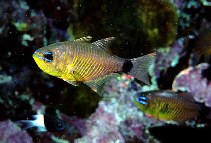
|
Taeniamia fucata (Cantor, 1849) Orangelined cardinalfish |

|
|
photo by
Field, R. |
| Family: | Apogonidae (Cardinalfishes), subfamily: Apogoninae | |||
| Max. size: | 10 cm TL (male/unsexed) | |||
| Environment: | reef-associated; marine; depth range 2 - 60 m | |||
| Distribution: | Indo-Pacific: Persian Gulf (Ref. 68964); Red Sea and east coast of Africa, eastward to the Marshall Islands, Samoa and Tonga; north to Ryukyu Islands; south to northern Australia. | |||
| Diagnosis: | Dorsal spines (total): 7-7; Dorsal soft rays (total): 9-9; Anal spines: 2-2; Anal soft rays: 15-18. Diagnosis: Dorsal VII,9; Anal II,15-17 (rarely 18); Pectoral rays 14 (rarely 13 or 15). Gill rakers 4-8 + 14-18 (total 19-25). Lateral-line scales 25+3-6. Median predorsal scales 6-7 (rarely 5). Body depth 2.3-2.9 in SL; body width 2.1-2.8 in body depth; eye diameter 2.7-3.5 in head length; first dorsal spine 1.5-2.7 in second spine; second dorsal spine 2.0-2.7, and third dorsal spine 2.2-2.7 in head length; spine of second dorsal fin 2.3-2.9, and second anal spine 2.5-3.2 in head length; pelvic-fin length 4.25-5.2 and caudal-peduncle length 4.7-6.8 in SL; distance from insertion of pelvic spine to anal-fin origin 3.9-5.6 in SL. Posterior preopercular edge variable, usually with few or no serrae above angle; ventral preopercular edge serrate on posterior two-thirds. Scaly sheath along anal-fin base moderately developed (Ref. 54391). Description: Color in life silvery, sometimes with yellow to orange hue with 20-23 narrow curved orange lines, the first 2 bars behind the opercle sometimes unite to form a diffuse vertically elongate orange mark between pectoral fin base and lateral line; yellow stripe from tip of snout to posterior end of orbit, edged in narrow iridescent blue reaching onto eye above and below pupil; cheek with dark dots, sometimes forming a wide dark cheek mark; large dark caudal spot, frequently diffuse in large adults; spot of juveniles smaller, about pupil size; fins pale, but leading edge of first dorsal fin, and sometimes second dorsal, pale orange; anal fin sometimes with faint orange basal stripe, tip of first 1-2 rays sometimes white (Ref. 54391). | |||
| Biology: | Inhabits continental and insular shelves; on coral and rocky reefs in sheltered bays and lagoon, patch reefs, with muddy, sandy and silty bottoms or coral rubble, and mangroves (Ref. 54391); typically forming dense aggregations at the entrance of caves (Ref. 1602, 48635) and among branching corals (Ref. 2334). Nocturnal species (Ref. 7300). | |||
| IUCN Red List Status: | Least Concern (LC); Date assessed: 05 February 2021 Ref. (130435) | |||
| Threat to humans: | harmless | |||